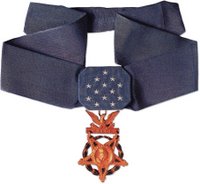ZUI this US Army
press release:
Representatives from the families of two Soldiers -- Pfc. Anthony Kaho'ohanohano and Pfc. Henry Svehla, who gave their lives for their comrades in Korea -- proudly received the Medal of Honor from President Barack Obama in the East Room of the White House, May 2, 2011.
Members of the families flew to Washington, D.C., from their homes in Hawaii, Texas, and New Jersey. They were joined by with Sen. Daniel Akaka of Hawaii and Congressman Bill Pascrell of New Jersey, who both sponsored the provision in the National Defense Authorization Act authorizing the Army to award posthumously the highest honor for conspicuous gallantry and intrepidity at the risk of life above and beyond the call of duty.
Both men were originally awarded the Distinguished Service Cross.
************* *** *************
ANTHONY T KAHO`OHANOHANO
Private First Class, US Army; Company H, 17th Infantry Regiment, 7th Infantry Division
Born: 1930, Maui, Territory of Hawai`i
Died: 1 September 1951, near Chup'a-ri, Korea

Citation: Private First Class Anthony T. Kaho'ohanohano, Company H, 17th Infantry Regiment, 7th Infantry Division, distinguished himself by extraordinary heroism in action against the enemy in the vicinity of Chupa-ri, Korea, on 1 September 1951. On that date, Private First Class Kaho'ohanohano was in charge of a machine-gun squad supporting the defensive positioning of Company F when a numerically superior enemy force launched a fierce attack. Because of the enemy's overwhelming numbers, friendly troops were forced to execute a limited withdrawal. As the men fell back, Private First Class Kaho'ohanohano ordered his squad to take up more defensible positions and provide covering fire for the withdrawing friendly force. Although having been wounded in the shoulder during the initial enemy assault, Private First Class Kaho'ohanohano gathered a supply of grenades and ammunition and returned to his original position to face the enemy alone. As the hostile troops concentrated their strength against his emplacement in an effort to overrun it, Private First Class Kaho'ohanohano fought fiercely and courageously, delivering deadly accurate fire into the ranks of the onrushing enemy. When his ammunition was depleted, he engaged the enemy in hand-to-hand combat until he was killed. Private First Class Kaho'ohanohano's heroic stand so inspired his comrades that they launched a counterattack that completely repulsed the enemy. Upon reaching Private First Class Kaho'ohanohano's emplacement, friendly troops discovered 11 enemy soldiers lying dead in front of the emplacement and two inside it, killed in hand-to-hand combat. Private First Class Kaho'ohanohano's extraordinary heroism and selfless devotion to duty are in keeping with the finest traditions of military service and reflect great credit upon himself, the 7th Infantry Division, and the United States Army.
HENRY SVEHLA
Private First Class, US Army; Company F, 32d Infantry Regiment, 7th Infantry Division
Born: 1932, Newark, New Jersey
Died: 12 June 1952, Pyongony, Korea

Citation: Private First Class Henry Svehla distinguished himself by acts of gallantry and intrepidity above and beyond the call of duty while serving as a Rifleman with F Company, 32d Infantry Regiment, 7th Infantry Division, in connection with combat operations against an armed enemy in Pyongony, Korea, on 12 June 1952. That afternoon while Private First Class Svehla and his platoon were patrolling a strategic hill to determine enemy strength and positions, they were subjected to intense enemy automatic weapons and small arms fire at the top of the hill. Coming under the heavy fire, the platoon's attack began to falter. Realizing the success of the mission and the safety of the remaining troops were in peril, Private First Class Svehla leapt to his feet and charged the enemy positions, firing his weapon and throwing grenades as he advanced. In the face of this courage and determination, the platoon rallied to the attack with renewed vigor. Private First Class Svehla, utterly disregarding his own safety, destroyed enemy positions and inflicted heavy casualties, when suddenly fragments from a mortar round exploding nearby seriously wounded him in the face. Despite his wounds, Private First Class Svehla refused medical treatment and continued to lead the attack. When an enemy grenade landed among a group of his comrades, Private First Class Svehla, without hesitation and undoubtedly aware of the extreme danger, threw himself upon the grenade. During this action, Private First Class Svehla was mortally wounded. Private First Class Svehla's extraordinary heroism and selflessness at the cost of his own life, above and beyond the call of duty, are in keeping with the highest traditions of the military service and reflect great credit upon himself, his unit, and the United States Army.




















